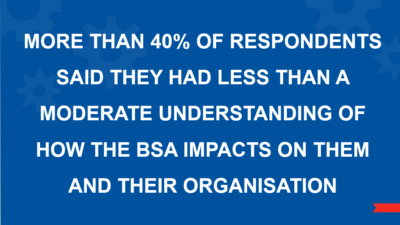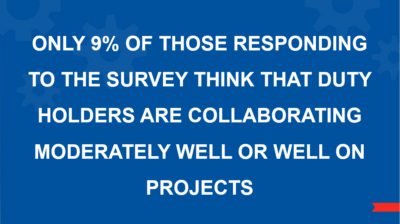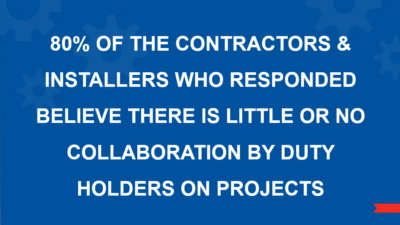“This is a strong, coherent strategy built on collaboration with all Building Safety Regulators’ stakeholders, with a keen focus on ensuring industry takes ownership and responsibility for delivering a safe system throughout the life cycle of a building. This must be front of mind for everyone. And everyone must be aware of their legal responsibilities. Collaboration and collective responsibility are key for delivering better standards.”
These were the worlds of Sarah Newton, Chair of the Health & Safety Executive at last November’s launch of the new Building Safety Regulator’s (BSR) first strategic plan.
How is the construction industry responding to Sarah’s call for action? A new survey from NBS into progress with implementation of the Building Safety Act (BSA) suggests that we still have some way to go. Responses from nearly 500 industry professionals indicate worrying levels of uncertainty about how to implement the golden thread of asset information that sits at the heart of the post Grenfell Tragedy regime for High Risk Buildings, and around the obligations for the named duty holders under the Act. One startling result is that only 20% of respondents said they were aware of their full responsibilities for structures categorised as high risk under the BSA.

The NBS study mirrors results of our own recent survey of BBA stakeholders. Comments from respondents to our survey provide some useful insight into what is going wrong. This includes a lack of information and guidance, a siloed, fractured industry, and a deep-rooted culture focusing on value engineering, risk transfer and cost saving. All these factors are blunting efforts to tackle the failings that were so brutally exposed by the Grenfell tragedy. The better news is that a closer examination of BBA’s results also highlights some of the ways forward that while not a complete solution to the industry’s engrained problems do offer an opportunity for collaboration to get the new building safety regime firmly on track.
Learning from the CDM Regulations – focusing on the intent of the Building Safety Act
At its heart, the goal of the Act is straightforward – if not simple to achieve. It envisages a construction sector in which all parts of the value chain collaborate to deliver safer buildings that are fully documented as built and then maintained to remain safe through their lifecycle. Stepping back from the detail of implementation, BBA found concern that parts of the industry are losing sight of these fundamentals.
One architect expressed frustration that, “there is a danger that the main focus of the BSA is lost, and project teams will just produce copious amounts of paperwork for the sake of it… there is a danger that lip service will be paid to it, rather than focusing real attention on those critical areas and projects that require it most”. In this context another lamented that because so much of the focus to date has been on the specific provisions relating to fire in high-risk buildings, this has obscured the fact that much of the Act applies to all buildings. They added that this was “understandable given what caused the Act in the first place, (but) we really need to use the opportunity across the construction sector to reduce or remove the race to the bottom”.
Respondents were also sceptical that the industry is embracing collaboration in the interests of Building Safety. Across all the groups of respondents, (which included architects, contractors/installers, distributors, manufacturers, building control, engineers and clients) the numbers responding “very well” or “completely” to the question, “how well do you feel duty holders are collaborating on projects”, is never higher than 20% and for some groups falls to zero.

A failure to collaborate creates obvious barriers for achieving the goals of the Act. As an industry we have however been here before. The Construction Design Management Regulations (CDM) have been around for over 30 years, with the most recent update issued in 2015. It doesn’t take a long internet search to find voices throughout this period worrying that duty holders under the act and the wider industry have been focusing on narrow legal compliance rather than the goal of collaborating to reduce deaths and injuries. Yet few would deny that progress has been made. One simple way for industry leaders to demonstrate ownership and responsibility would be to instigate a serious effort to draw out the lessons for the Building Safety Act from the 3 decades of implementation of the various incarnations of the CDM Regulations.
Making sure we understand our roles and responsibilities – collaborating to fill gaps in individual and organisational knowledge
The BBA survey shows a wide variance in understanding of the implications of the new regime. Only 65% of architectural businesses that responded and less then 40% of contracting businesses told us that they understood the impacts on their business “very well” or “completely”. This is a worrying figure given the key duty holders of Principal Designer and Principal Contractor identified in the BSA will often be drawn from these organisations.
When we asked how well individual professionals understood their spec ific responsibilities these figures did grow, but the only group to consistently reply that they understood the specific responsibilities “completely” were Building Control Officers. The detailed comments from survey respondents suggest that enforcement of competency assessment has been very high in this part of the sector, something that may offer a source of learning for colleagues in other parts of the system.
ific responsibilities these figures did grow, but the only group to consistently reply that they understood the specific responsibilities “completely” were Building Control Officers. The detailed comments from survey respondents suggest that enforcement of competency assessment has been very high in this part of the sector, something that may offer a source of learning for colleagues in other parts of the system.
Looking at a broader range of comments from survey respondents, a couple of themes emerge that also look like opportunities to make progress. Several contributors argue that given the complexity of the legalisation it was unfortunate that the Building Services Regulator was not ready with formal guidance from day one of the new regime (which is also a strong theme of the NBS survey discussed above). The BSR clearly does have an opportunity to fill this gap rapidly. It is however important that key players across the industry don’t act as if communications and education around the Act is a task solely for government and the regulator. Under the intended spirit of the regime, this should be a shared responsibility, particularly for organisations whose position in the eco-system makes them especially influential. As an example, our survey, unsurprisingly, indicates that small sub-contractors (often with a handful of staff or acting as sole traders) can find it difficult to keep up with change. Clients and main contractors surely have a role in educating their supply chain. Industry bodies and trade associations can also step up.
Putting professionalism, competency and trust at the heart of product specification and installation
At BBA we certainly believe we have a part to play. We are engaged with many parts of the chain of organisations that create and maintain buildings. We will use our influence to encourage collaboration that can strengthen this chain.
We will also work to improve understanding in key areas such as the role of product certification in the new regime. We can’t, however, do this alone. Again, stepping back to fundamentals, what we are really trying to achieve is a system in which everyone involved trusts that manufacturers provide reliable product information, designers specify appropriate products, and that contractors will build what has been designed and install the specified products correctly. This all then needs to be recorded accurately and consistently to help create the “golden thread”.
In practice of course the world is more complicated. For example, under the BSA the rules around product substitution are more stringent for High-Risk Buildings, some products or systems are considered safety critical and need more attention, (although the exact list of these is yet to be confirmed), and in many cases designers will use performance specifications rather than direct the use of a specific product. In addition, to build trust and to allow all duty holders to meet their obligations, it is desirable that contractors check back with the original specifier to understand their intent and ensure they are aware. This further reinforces the need for better education around all aspect of the BSA regime.. Finally, for HRBs it is vital that contractors understand that the BSA regime has introduced much tougher rules for change control. Any change must be logged and if a product or system is significant, the Building Safety Regulator must be informed. If a safety critical system is involved (for example passive and active fire systems) this constitutes a major change that needs approval from the BSR.
All of this complexity makes it even more vital that businesses throughout the value chain work together to establish and maintain the competence of the cadre of people people who are doing this specification, installation and, where appropriate, product substitution.
Strengthening the Golden Thread
The golden thread of asset information is a central plank of the new regime for High Risk Buildings. It seeks to ensure that the right people have the right information at the right time to achieve the goals of the Act. To help achieve this goal duty holders have an obligation to capture and maintain a digital log of key information about a building’s design, safety and management.

The picture here is also a little murky. When asked “how well is the golden thread of implementation being implemented and used” respondents to the BBA survey gave a high number of neutral responses.. Worryingly however, those who do have an opinion tend strongly towards the negative, for example nearly 70% of Building Control professionals answered “poorly” or “not at all well”, although this figure drops below 50% for architect/specifiers and manufacturers.
This further reinforces the need for better education around all aspects of the BSA regime and looks like an area where there would be a value in industry players coming together to develop guidance on what is required to create the golden thread and how it can be delivered. This will need to cover the whole lifecycle from product development, through the technical information provided by manufacturers and into design, construction and the management of the built asset. Some industry commentators have also criticised the Act for failing to prescribe the format in which golden thread data should be captured. If this is a barrier to greater quality and consistency, there could be a role within a project to create guidance to establish a de-facto standard (or simply mandate the ISO 19650 Building Information Standards).
Time to step up
The Building Safety Act isn’t just another piece of legislation. It is a response to an avoidable tragedy that cost 72 people their lives and shone a light on industry culture and practices that we must address. As an industry, we need to listen to Sarah Newton and take ownership and responsibility, first for ensuring that the whole value chain understands its new roles and responsibilities and then to collaborate to drive a wider culture change that respects the spirit of the Act and not just its letter.
Share This Story, Choose Your Platform!
Related News
“This is a strong, coherent strategy built on collaboration with all Building Safety Regulators’ stakeholders, with a keen focus on ensuring industry takes ownership and responsibility for delivering a safe system throughout the life cycle of a building. This must be front of mind for everyone. And everyone must be aware of their legal responsibilities. Collaboration and collective responsibility are key for delivering better standards.”
These were the worlds of Sarah Newton, Chair of the Health & Safety Executive at last November’s launch of the new Building Safety Regulator’s (BSR) first strategic plan.
How is the construction industry responding to Sarah’s call for action? A new survey from NBS into progress with implementation of the Building Safety Act (BSA) suggests that we still have some way to go. Responses from nearly 500 industry professionals indicate worrying levels of uncertainty about how to implement the golden thread of asset information that sits at the heart of the post Grenfell Tragedy regime for High Risk Buildings, and around the obligations for the named duty holders under the Act. One startling result is that only 20% of respondents said they were aware of their full responsibilities for structures categorised as high risk under the BSA.

The NBS study mirrors results of our own recent survey of BBA stakeholders. Comments from respondents to our survey provide some useful insight into what is going wrong. This includes a lack of information and guidance, a siloed, fractured industry, and a deep-rooted culture focusing on value engineering, risk transfer and cost saving. All these factors are blunting efforts to tackle the failings that were so brutally exposed by the Grenfell tragedy. The better news is that a closer examination of BBA’s results also highlights some of the ways forward that while not a complete solution to the industry’s engrained problems do offer an opportunity for collaboration to get the new building safety regime firmly on track.
Learning from the CDM Regulations – focusing on the intent of the Building Safety Act
At its heart, the goal of the Act is straightforward – if not simple to achieve. It envisages a construction sector in which all parts of the value chain collaborate to deliver safer buildings that are fully documented as built and then maintained to remain safe through their lifecycle. Stepping back from the detail of implementation, BBA found concern that parts of the industry are losing sight of these fundamentals.
One architect expressed frustration that, “there is a danger that the main focus of the BSA is lost, and project teams will just produce copious amounts of paperwork for the sake of it… there is a danger that lip service will be paid to it, rather than focusing real attention on those critical areas and projects that require it most”. In this context another lamented that because so much of the focus to date has been on the specific provisions relating to fire in high-risk buildings, this has obscured the fact that much of the Act applies to all buildings. They added that this was “understandable given what caused the Act in the first place, (but) we really need to use the opportunity across the construction sector to reduce or remove the race to the bottom”.
Respondents were also sceptical that the industry is embracing collaboration in the interests of Building Safety. Across all the groups of respondents, (which included architects, contractors/installers, distributors, manufacturers, building control, engineers and clients) the numbers responding “very well” or “completely” to the question, “how well do you feel duty holders are collaborating on projects”, is never higher than 20% and for some groups falls to zero.

A failure to collaborate creates obvious barriers for achieving the goals of the Act. As an industry we have however been here before. The Construction Design Management Regulations (CDM) have been around for over 30 years, with the most recent update issued in 2015. It doesn’t take a long internet search to find voices throughout this period worrying that duty holders under the act and the wider industry have been focusing on narrow legal compliance rather than the goal of collaborating to reduce deaths and injuries. Yet few would deny that progress has been made. One simple way for industry leaders to demonstrate ownership and responsibility would be to instigate a serious effort to draw out the lessons for the Building Safety Act from the 3 decades of implementation of the various incarnations of the CDM Regulations.
Making sure we understand our roles and responsibilities – collaborating to fill gaps in individual and organisational knowledge
The BBA survey shows a wide variance in understanding of the implications of the new regime. Only 65% of architectural businesses that responded and less then 40% of contracting businesses told us that they understood the impacts on their business “very well” or “completely”. This is a worrying figure given the key duty holders of Principal Designer and Principal Contractor identified in the BSA will often be drawn from these organisations.
When we asked how well individual professionals understood their spec ific responsibilities these figures did grow, but the only group to consistently reply that they understood the specific responsibilities “completely” were Building Control Officers. The detailed comments from survey respondents suggest that enforcement of competency assessment has been very high in this part of the sector, something that may offer a source of learning for colleagues in other parts of the system.
ific responsibilities these figures did grow, but the only group to consistently reply that they understood the specific responsibilities “completely” were Building Control Officers. The detailed comments from survey respondents suggest that enforcement of competency assessment has been very high in this part of the sector, something that may offer a source of learning for colleagues in other parts of the system.
Looking at a broader range of comments from survey respondents, a couple of themes emerge that also look like opportunities to make progress. Several contributors argue that given the complexity of the legalisation it was unfortunate that the Building Services Regulator was not ready with formal guidance from day one of the new regime (which is also a strong theme of the NBS survey discussed above). The BSR clearly does have an opportunity to fill this gap rapidly. It is however important that key players across the industry don’t act as if communications and education around the Act is a task solely for government and the regulator. Under the intended spirit of the regime, this should be a shared responsibility, particularly for organisations whose position in the eco-system makes them especially influential. As an example, our survey, unsurprisingly, indicates that small sub-contractors (often with a handful of staff or acting as sole traders) can find it difficult to keep up with change. Clients and main contractors surely have a role in educating their supply chain. Industry bodies and trade associations can also step up.
Putting professionalism, competency and trust at the heart of product specification and installation
At BBA we certainly believe we have a part to play. We are engaged with many parts of the chain of organisations that create and maintain buildings. We will use our influence to encourage collaboration that can strengthen this chain.
We will also work to improve understanding in key areas such as the role of product certification in the new regime. We can’t, however, do this alone. Again, stepping back to fundamentals, what we are really trying to achieve is a system in which everyone involved trusts that manufacturers provide reliable product information, designers specify appropriate products, and that contractors will build what has been designed and install the specified products correctly. This all then needs to be recorded accurately and consistently to help create the “golden thread”.
In practice of course the world is more complicated. For example, under the BSA the rules around product substitution are more stringent for High-Risk Buildings, some products or systems are considered safety critical and need more attention, (although the exact list of these is yet to be confirmed), and in many cases designers will use performance specifications rather than direct the use of a specific product. In addition, to build trust and to allow all duty holders to meet their obligations, it is desirable that contractors check back with the original specifier to understand their intent and ensure they are aware. This further reinforces the need for better education around all aspect of the BSA regime.. Finally, for HRBs it is vital that contractors understand that the BSA regime has introduced much tougher rules for change control. Any change must be logged and if a product or system is significant, the Building Safety Regulator must be informed. If a safety critical system is involved (for example passive and active fire systems) this constitutes a major change that needs approval from the BSR.
All of this complexity makes it even more vital that businesses throughout the value chain work together to establish and maintain the competence of the cadre of people people who are doing this specification, installation and, where appropriate, product substitution.
Strengthening the Golden Thread
The golden thread of asset information is a central plank of the new regime for High Risk Buildings. It seeks to ensure that the right people have the right information at the right time to achieve the goals of the Act. To help achieve this goal duty holders have an obligation to capture and maintain a digital log of key information about a building’s design, safety and management.

The picture here is also a little murky. When asked “how well is the golden thread of implementation being implemented and used” respondents to the BBA survey gave a high number of neutral responses.. Worryingly however, those who do have an opinion tend strongly towards the negative, for example nearly 70% of Building Control professionals answered “poorly” or “not at all well”, although this figure drops below 50% for architect/specifiers and manufacturers.
This further reinforces the need for better education around all aspects of the BSA regime and looks like an area where there would be a value in industry players coming together to develop guidance on what is required to create the golden thread and how it can be delivered. This will need to cover the whole lifecycle from product development, through the technical information provided by manufacturers and into design, construction and the management of the built asset. Some industry commentators have also criticised the Act for failing to prescribe the format in which golden thread data should be captured. If this is a barrier to greater quality and consistency, there could be a role within a project to create guidance to establish a de-facto standard (or simply mandate the ISO 19650 Building Information Standards).
Time to step up
The Building Safety Act isn’t just another piece of legislation. It is a response to an avoidable tragedy that cost 72 people their lives and shone a light on industry culture and practices that we must address. As an industry, we need to listen to Sarah Newton and take ownership and responsibility, first for ensuring that the whole value chain understands its new roles and responsibilities and then to collaborate to drive a wider culture change that respects the spirit of the Act and not just its letter.
Share This Story, Choose Your Platform!
Related News
Get in touch
Please complete the form below and we will contact you as soon as possible.
To help us to respond to your inquiry as quickly as possible, we have put a handy list of our services below.


